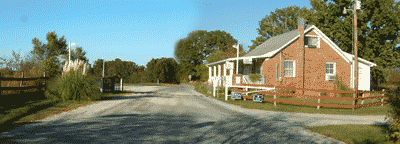A very brief review of the evolution of Farm architecture
by Albert Bates
Communal Studies Association
Oneida Mansion House
October 1984
Building design in the utopian experiment of The Farm was driven by a number of forces. The distinct evolution of design reveals the varying mix of these forces during The Farm's development.
The first designs were not particularly utilitarian. They were the fulfillment of the architectural dreams of some of the pioneering members. Many were so lacking in functionality that they no longer exist, having collapsed of their own weight or the persistence of local flora and fauna. The buildings erected prior to 1973 included a round house with a spiral roof; a mortise and tenon half-frame/half fieldstone studio; a 32-foot dome; a 16-foot dome; two native oak D-frame cottages; a pole-frame cabin; an adobe apartment house; a Salt Box home; and two small two-story oak frame houses. All were built without power tools. All were single family or extended (four-marriage or paired-couple) family dwellings.
The roundhouse, adobe apartment, and domes leaked until they became uninhabitable, then rotted away and were demolished. The mortise and tenon was expanded to apartment size, then duplexed, and is now undergoing extensive restoration as a large family house or Inn. The D-frames leaked badly and have been uninhabited for some years and will be demolished unless rescued. The pole frame was expanded with an addition, then renovated. The Salt Box was originally built for an elderly couple, but became our neo-natal intensive care center and birthing house when they left. It was intended to serve as a model, with easily replicable design, but proved too small. It is now called the Tower Road House and is maintained by the midwives for use as a birthing center. The two oak frame buildings were poorly constructed and are aging badly, although they are still lived in. Also, a community bathhouse built during this early period has been successfully remodeled as a family home.
After 1973, with the population increasing quickly, an effort was made to build much larger buildings. These were considered temporary, envisioning a duration of perhaps 20-30 years. The building materials were mostly scrap or very cheap lumber. Nails and braces were employed sparingly. Most were left unfinished, with just the blackwall exteriors and tarpaper roofs. Up to 100 people lived in these apartment houses. A number of these did not survive even 10 years. Some were lost to fire, others to disrepair. During the same period numerous buildings were purchased "on the hoof" and trucked into the Farm. All of these "moved" buildings still survive, although they are relatively small, single family dwellings. A number of the larger buildings have also survived, and have become single-family or duplex with the change in our demography. They do not follow any uniform design because they were not constructed with purchased but rather with "found" materials. Even the head of the construction crew lacked the ability to purchase a new 2x4 when building his 8,000 sq. ft. home. However he brought more skill and tools to the task than most people.
Prior to 1978, there was insufficient funding to permit town planners to have their way with on-the-farm construction needs. First priorities went to income-producing structures like tractor barn, potato barn, print shop, flour mill, machine shop, etc. and provision was made for home construction only by providing salvaged materials and salvaging opportunities in an organized way. Design was left to the builder-occupant. Many buildings were simply extensions or modifications to army tents, lean-tos and school buses.
In 1981, with a recession in the building trades, there was an opportunity for the highly skilled carpenters and masons to come home and, at last (having built hundreds of houses off the Farm) build some good houses to town planner's specifications. Two of these homes are visible on the way down to my house, the Robert Lord and Edward Sierra residences. Both are passive solar orientation, large two-story, super-insulated, expandable, and replicable, with solar water heating and flush toilets. They were to be models for many more, same design: capacity 5-20 people, low maintenance, low overhead, and high sanitary standards. The collapse of the Farm's economy in 1982-83 prevented more from being built, and in fact the two I mention had to be finished in with windows and doors salvaged in the traditional manner.
So, to recap, indeed we did attempt to construct easily expandable, repetitious buildings to cope with the late 70s period of dense occupation. But the first decade of the Farm's history was dominated by variables such as:
-
Lack of construction skill and experience
-
Lack of money and financial skill
-
Lack of spare time
-
Availability of scrap and salvaged material
-
Growing awareness of solar and renewable energy systems
-
Growing environmental awareness
-
High population density
-
Low architect-to-builder ratio
The second decade is much different. The variables added to the mix included:
-
Considerable construction skill and experience
-
A greater degree of money and financial skill
-
A greater availability of spare time
-
Strong awareness of solar and renewable energy systems
-
Strong environmental awareness
-
Low population density
-
Low architect-to-builder ratio
-
A developing sense of community aesthetics
Consequently, what was built later, while based on what pre-existed, was much more carefully thought out, better constructed, and more closely woven into a natural forest environment.
Finally, I want to just touch on a point about the semblance to rural or suburban housing styles. Many of us moved into the Farm and straight into a large dormitory setting, either in a group tent or bus full of single people, or later into a large apartment house. Single family dwellings were always at a premium, and many of us learned carpentry or masonry specifically so we could build a private residence when the means became available. Perhaps this is a reflection of suburban upbringing, but just possibly it is an expression of human tropism long in evolution -- the small hut in the larger, but still close, village. We just did what came naturally, and frankly, barracks didn't.
 |  |  |  |
|---|---|---|---|
 |  |  |  |
 |  |  |  |
 |  |  |  |
 |  |  |  |
 |  |  |  |
 |  |  |  |
 |  |  |  |
 |  |  |  |
 |  |  |  |
 |
